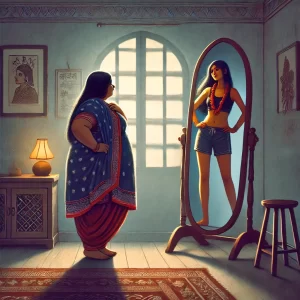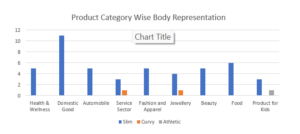 Media has long shaped societal norms and influenced how people perceive the world. Among various forms, television with its reach and impact, has historically contributed to setting standards of gender roles, body image and attractiveness. Advertisements, in particular, play a pivotal role in embedding aspirational ideals into public consciousness, often showcasing images that are far removed from reality.
Media has long shaped societal norms and influenced how people perceive the world. Among various forms, television with its reach and impact, has historically contributed to setting standards of gender roles, body image and attractiveness. Advertisements, in particular, play a pivotal role in embedding aspirational ideals into public consciousness, often showcasing images that are far removed from reality.
In India, where television is a dominant source of information and entertainment, advertisements significantly influence cultural expectations around beauty, gender roles and success. Indian TV commercials, often seen as mirrors of societal values, prominently project narrow and unrealistic beauty standards, impacting how young women perceive themselves.
Advertising holds immense power to shape societal perceptions of beauty by promoting aspirational yet unattainable ideals. In India, the emphasis on slimness and fair skin in commercials is pervasive. These traits, often unrelated to the products advertised, create distorted perceptions of beauty. Over time, such portrayals significantly affect women’s self-esteem, leading to body dissatisfaction and in extreme cases, eating disorders.
Society’s obsession with the “perfect” body perpetuates an environment where many women, especially teenagers, struggle with body confidence. Images of underweight, photoshopped models dominate media platforms, setting unrealistic benchmarks for what young women should look like. This pressure not only deteriorates self-esteem but also fosters unhealthy habits in the pursuit of unattainable ideals.
The pervasive nature of idealized portrayals in Indian TV commercials profoundly impacts young women’s self-perception and mental health. A study conducted in Chennai with 915 participants revealed that 30% of women felt societal pressure from advertisements to conform to these beauty standards. Alarmingly, 76% expressed a desire for a smaller body size, underscoring the deep internalization of these unattainable ideals.
Repeated exposure to such imagery leads to heightened body dissatisfaction, eroded self-esteem and emotional distress. Women exposed to thin-ideal images in controlled studies reported significantly lower self-esteem and greater body dissatisfaction than those exposed to neutral content. This psychological toll often manifests in harmful coping mechanisms, including extreme dieting, over-exercising and disordered eating habits. These behaviors not only jeopardize physical health but also perpetuate a cycle of mental and emotional strain.
One of the most glaring issues in Indian TV advertising is the lack of diversity in how women are portrayed. Most commercials feature slim, fair-skinned and youthful women, excluding individuals of varying body types, skin tones and age groups. This narrow representation reinforces the harmful notion that only certain appearances are socially acceptable or desirable, marginalizing the majority who do not conform to these ideals.
Beyond this limited representation, many advertisements employ emotionally manipulative messaging. Commercials often equate physical appearance with essential life goals like happiness, success, and romantic fulfillment. For instance, fair skin is associated with career advancement, while a slim figure is portrayed as key to social acceptance and desirability. Such messaging pressures women to purchase products that promise transformative results, subtly suggesting their worth is tied to their appearance.
The damaging effects of these portrayals highlight the urgent need for a fundamental shift in advertising practices. The industry must embrace inclusivity by representing a broader spectrum of body types, skin tones and life experiences. Such a shift would reflect India’s rich diversity and foster a more empowering media environment.
Empowering viewers is equally crucial. Promoting media literacy and critical thinking skills can equip consumers especially young women to question and resist harmful stereotypes perpetuated by advertisements. Educational initiatives that teach audiences to recognize and critique manipulative marketing strategies can shift the power dynamic, fostering a more informed and self-assured generation.
To combat the damaging influence of unrealistic beauty standards, a dual approach is essential. Advertisers must prioritize inclusivity and diversity, moving away from perpetuating outdated ideals. At the same time, educators and activists should empower young women to value their individuality beyond physical appearance.
A recent study examining Indian TV commercials revealed that slim, fair-skinned women dominate advertisements across product categories, from beauty and fashion to household goods and financial services. This uniform portrayal reinforces aspirational ideals that exclude significant portions of the population. The normalization of such limited standards as benchmarks for beauty and desirability further emphasizes the need for change.
Media has long shaped societal norms and influenced how people perceive the world. Among various forms, television with its reach and impact, has historically contributed to setting standards of gender roles, body image and attractiveness. Advertisements, in particular, play a pivotal role in embedding aspirational ideals into public consciousness, often showcasing images that are far removed from reality.
In India, where television is a dominant source of information and entertainment, advertisements significantly influence cultural expectations around beauty, gender roles and success. Indian TV commercials, often seen as mirrors of societal values, prominently project narrow and unrealistic beauty standards, impacting how young women perceive themselves.
Advertising holds immense power to shape societal perceptions of beauty by promoting aspirational yet unattainable ideals. In India, the emphasis on slimness and fair skin in commercials is pervasive. These traits, often unrelated to the products advertised, create distorted perceptions of beauty. Over time, such portrayals significantly affect women’s self-esteem, leading to body dissatisfaction and in extreme cases, eating disorders.
Society’s obsession with the “perfect” body perpetuates an environment where many women, especially teenagers, struggle with body confidence. Images of underweight, photoshopped models dominate media platforms, setting unrealistic benchmarks for what young women should look like. This pressure not only deteriorates self-esteem but also fosters unhealthy habits in the pursuit of unattainable ideals.
The pervasive nature of idealized portrayals in Indian TV commercials profoundly impacts young women’s self-perception and mental health. A study conducted in Chennai with 915 participants revealed that 30% of women felt societal pressure from advertisements to conform to these beauty standards. Alarmingly, 76% expressed a desire for a smaller body size, underscoring the deep internalization of these unattainable ideals.
Repeated exposure to such imagery leads to heightened body dissatisfaction, eroded self-esteem and emotional distress. Women exposed to thin-ideal images in controlled studies reported significantly lower self-esteem and greater body dissatisfaction than those exposed to neutral content. This psychological toll often manifests in harmful coping mechanisms, including extreme dieting, over-exercising and disordered eating habits. These behaviors not only jeopardize physical health but also perpetuate a cycle of mental and emotional strain.
One of the most glaring issues in Indian TV advertising is the lack of diversity in how women are portrayed. Most commercials feature slim, fair-skinned and youthful women, excluding individuals of varying body types, skin tones and age groups. This narrow representation reinforces the harmful notion that only certain appearances are socially acceptable or desirable, marginalizing the majority who do not conform to these ideals.
Beyond this limited representation, many advertisements employ emotionally manipulative messaging. Commercials often equate physical appearance with essential life goals like happiness, success, and romantic fulfillment. For instance, fair skin is associated with career advancement, while a slim figure is portrayed as key to social acceptance and desirability. Such messaging pressures women to purchase products that promise transformative results, subtly suggesting their worth is tied to their appearance.
The damaging effects of these portrayals highlight the urgent need for a fundamental shift in advertising practices. The industry must embrace inclusivity by representing a broader spectrum of body types, skin tones and life experiences. Such a shift would reflect India’s rich diversity and foster a more empowering media environment.
Empowering viewers is equally crucial. Promoting media literacy and critical thinking skills can equip consumers especially young women to question and resist harmful stereotypes perpetuated by advertisements. Educational initiatives that teach audiences to recognize and critique manipulative marketing strategies can shift the power dynamic, fostering a more informed and self-assured generation.
To combat the damaging influence of unrealistic beauty standards, a dual approach is essential. Advertisers must prioritize inclusivity and diversity, moving away from perpetuating outdated ideals. At the same time, educators and activists should empower young women to value their individuality beyond physical appearance.
A recent study examining Indian TV commercials revealed that slim, fair-skinned women dominate advertisements across product categories, from beauty and fashion to household goods and financial services. This uniform portrayal reinforces aspirational ideals that exclude significant portions of the population. The normalization of such limited standards as benchmarks for beauty and desirability further emphasizes the need for change.





